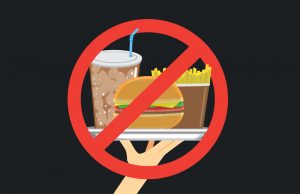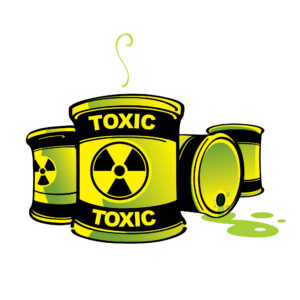Would You Like Phthalates With Your Burgers?
Author: Dr. Stephen Chaney
 Every once in a while, a scientific study grabs the headlines and causes a paradigm shift in our thinking. One such study, published in 2016, showed that babies’ umbilical cords contained over 200 toxic chemicals.
Every once in a while, a scientific study grabs the headlines and causes a paradigm shift in our thinking. One such study, published in 2016, showed that babies’ umbilical cords contained over 200 toxic chemicals.
That study created instant headlines. It grabbed our attention. People were asking, “How did our bodies get so contaminated?”
Sure, there were clues. There were many studies showing that individual toxic chemicals in our environment were making their way into our bodies. But no one anticipated the full scope of the problem. Nobody anticipated that our bodies had become toxic waste dumps.
And the very thought that newborn babies were starting their lives with so many toxic chemicals in their bodies was frightening. No one knows what the long-term health consequences will be.
What Are Phthalates And Why Should You Care?
 Phthalates are a class of compounds that are widely used in the manufacture of household products we use every day. For example, in shampoos and hair gels they increase spreadability, enhance absorption, and help make fragrances last longer. In hairsprays they make the hair softer and more flexible. And from shampoos, hair gels, and hairsprays they can be absorbed into our bodies through our scalp.
Phthalates are a class of compounds that are widely used in the manufacture of household products we use every day. For example, in shampoos and hair gels they increase spreadability, enhance absorption, and help make fragrances last longer. In hairsprays they make the hair softer and more flexible. And from shampoos, hair gels, and hairsprays they can be absorbed into our bodies through our scalp.
They are also used as “plasticizers” to make certain plastics more flexible and more durable. This is an issue because phthalates are added to some food packaging and materials used to handle and process food. And from there they can migrate into the food. This is especially true for fast foods and highly processed foods.
So, most of us are exposed to phthalates. We accumulate them in our bodies. The question is, “How harmful are these chemicals? Should we be concerned?” As with many other chemicals in our environment, the answer isn’t clear.
Phthalates belong to a class of chemicals called “hormone disruptors”. In animal studies phthalates disrupt the reproductive system, especially in males. They can cause developmental problems in the offspring. And they appear to increase the risk of some cancers.
In humans there is emerging evidence that phthalate exposure during pregnancy may impair a child’s brain development and increase their risk for learning, behavioral, and attention disorders.
At the other end of the spectrum, a recent study found a link between increased phthalate exposure and premature death in older Americans. The authors of that study estimated that phthalate exposure may lead to roughly 100,000 premature deaths each year, resulting in an economic burden of between $40 and $47 billion per year.
Would You Like Phthalates With Your Burger?
 That question brings me to the study (L Edwards et al, Journal of Exposure Science & Environmental Epidemiology, October 27, 2021) I want to discuss today. This was a preliminary study, so the authors focused on only a few fast foods from 6 fast food chains in the San Antonio area and a single source of phthalate contamination. They measured levels of 11 different phthalates in:
That question brings me to the study (L Edwards et al, Journal of Exposure Science & Environmental Epidemiology, October 27, 2021) I want to discuss today. This was a preliminary study, so the authors focused on only a few fast foods from 6 fast food chains in the San Antonio area and a single source of phthalate contamination. They measured levels of 11 different phthalates in:
- Hamburgers, chicken nuggets, and French fries from two hamburger chains.
- Chicken burritos from two Tex-Mex chains.
- Cheese pizzas from two pizza chains.
- Plastic gloves from two hamburger chains and one Tex-Mex chain.
Each of the phthalates they tested has different properties and different risks. But for purposes of simplicity, I will only discuss total phthalate levels for this review.
Here is what the study found:
- 10 of the 11 phthalates they analyzed were found in the foods they tested.
- 86% of the foods they tested were contaminated with one or more phthalate.
- Chicken burritos were the most contaminated food, followed by hamburgers, French fries, and chicken nuggets. Cheese pizza was the least contaminated food.
- High levels of phthalates were found in the plastic gloves in all 3 locations tested, indicating that the plastic gloves used for handling the foods are one likely source of food contamination.
The authors concluded, “Our findings suggest that phthalates…are abundant in prepared meals available at popular fast-food restaurants. In addition, they are found in food handling gloves, which may be a source of food contamination. These data support prior observations that consumption of highly processed and prepared foods contribute to human exposure of phthalates. Many of these chemicals have been associated with adverse health outcomes or, based on in vitro data, have the potential to be harmful to human health. These results, if confirmed, may inform individual and regulatory reduction strategies.”
In summary, while the evidence is not yet definitive, it is strong enough for us to ask how we might reduce our exposure to phthalates.
How Did Our Bodies Get So Contaminated?
 The sobering thought is that this study is just the tip of the iceberg. It looked at 11 chemicals found in 5 foods from 6 fast-food chains and identified one potential source of the chemical contamination of those foods. The problem is much larger.
The sobering thought is that this study is just the tip of the iceberg. It looked at 11 chemicals found in 5 foods from 6 fast-food chains and identified one potential source of the chemical contamination of those foods. The problem is much larger.
- Crops are sprayed with pesticides and herbicides. Contaminants can also come from polluted surface and ground water.
- Hormones and chemicals are used to make animals grow faster, and some of these chemicals make their way into the meats.
- Chemicals are added to processed and fast foods to prevent spoilage and give them the desired properties.
- Processed and fast foods are produced in factories, often packaged in plastic, and shipped to distant locations where they will be handled by people wearing plastic gloves.
- We are even starting to see meats and produce sold in grocery stores prewrapped in plastic.
- And, of course, we are exposed to chemicals in our cosmetics, personal care products, and household products. We are even exposed to chemicals through outgassing of our household furnishings.
Once you start to think about all the ways we are exposed to chemicals in our daily lives, it is easy to understand how we can end up with over 200 chemicals in an infant’s umbilical cord blood. It’s easy to understand how our bodies got so contaminated.
Each chemical is present at very low levels. If you look at each chemical individually, you might be tempted to conclude the risk is too small to be concerned about. But when you have hundreds of these chemicals in your body, their effect is cumulative. The risk can become significant.
What Can We Do?
Phthalates are so pervasive in our environment that it would be impossible to completely eliminate our exposure to them. However, there are some ways we can minimize our exposure:
1) Buy organic whenever possible.
2) Eat as close to nature as possible. By that I mean:
-
- Buy your produce at your local farmer’s market whenever possible.
-
- Choose grocery stores that source locally and do not wrap meat and produce in plastic.
3) Avoid fast foods and highly processed foods. You already know they are unhealthy. If you needed one more reason to avoid them, this would be it.
4) Read the labels of personal care products and cosmetics and choose those without phthalates.
The Bottom Line
Phthalates belong to a class of chemicals called “hormone disruptors”. In animal studies phthalates disrupt the reproductive system, especially in males. They can cause developmental problems in the offspring.
In humans there is emerging evidence that phthalate exposure during pregnancy may impair a child’s brain development and increase their risk for learning, behavioral, and attention disorders. At the other end of the spectrum, a recent study found a link between increased phthalate exposure and premature death in older Americans.
Some previous studies have suggested that processed and fast foods may be contaminated with phthalates. The study discussed in this article looked at 11 phthalates found in 5 foods from 6 fast-food chains and looked at the plastic gloves used to handle the food as one potential source of phthalate contamination. The study found:
- 86% of the foods they tested were contaminated with one or more phthalate.
- Chicken burritos were the most contaminated food, followed by hamburgers, French fries, and chicken nuggets. Cheese pizza was the least contaminated food.
- High levels of phthalates were found in the plastic gloves, indicating that the plastic gloves used for handling the foods are one likely source of food contamination.
The authors concluded, “Our findings suggest that phthalates…are abundant in prepared meals available at popular fast-food restaurants. In addition, they are found in food handling gloves, which may be a source of food contamination. These data support prior observations that consumption of highly processed and prepared foods contribute to human exposure of phthalates. These results, if confirmed, may inform individual and regulatory reduction strategies.”
I discuss how to minimize our exposure to phthalates in the article above.
For more details, read the article above.
These statements have not been evaluated by the Food and Drug Administration. This information is not intended to diagnose, treat, cure or prevent any disease.
